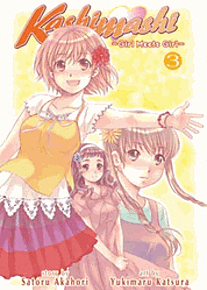Review
by Theron Martin,Kashimashi ~Girl Meets Girl~
GN 3
| Synopsis: |  |
||
Envying the long-time connection that Tomari has to her beloved Hazumu, Yasuna seems to concede defeat to Tomari and agrees to cover Hazumu's after-school duties while she goes out on a date with Tomari. When Yasuna falls ill, however, Sora's alert brings Hazumu rushing back with Tomari in tow. As summer activities progress through fireworks, a pajama party, and a sports festival, the two rivals come to an understanding about Hazumu: combining their efforts will ultimately be more successful than being at odds. That doesn't help Asuta, who still struggles with fantasizing over his breast. . . er, best friend, or Namiko-sensei, who still tries in vain to win the alien Sora's attention, but the insistent Jan-Puu still makes sure she gets her share of Hazumu time. The end of the sports festival brings a startling revelation about Hazumu's condition and the process that turned him into a girl, however, one whose implications run dire and deep. |
|||
| Review: | |||
The first two volumes of Kashimashi concentrated on setting up the series' central all-girl love triangle while also showing Hazumu's adjustments to the reality of being a girl (and, likewise, the adjustments everyone else had to make to him now irrevocably being a girl). Just when the third volume looks like it will progress down the well-traveled path of rivalry in matters of the heart over an indecisive central character, though, it takes an unexpected left turn: instead of fighting, Yasuna and tomari agree to work together to be happy with Hazumu. Such an arrangement would not be unusual for a hentai title or an ero game, where it provides an excuse for a threesome, but one does not get the same kind of vibe here. Instead the decisive scene between tomari and Kasuna conveys the kind of honest earnestness that has typified the story so far. However mundane the volume may have seemed up to that point, that moment will swing you back to an appreciation of how special this title can be when at its best. Of course, eliminating the rivalry also eliminates one of the key points of conflict in the story, so writer Satoru Akahori had to come up with something else to fill the void after a few chapters of frivolity. The ensuing bombshell rocks the story to its core, changing the tone of the story in a single blow and suggesting that volume four could be a much more serious affair than volume three. Unfortunately we will have to wait a few months to see how that bears out. Although Yasuna's past has been explored before, we get a double-dose of review on it in the early chapters of this volume; once from Yasuna's perspective, and once from Hazumu's. Much of it is just rehashing what has been told before, although this time it focuses more on the feelings of the two than the events. Asuta, Sora, and Jan-Puu also get their shares of supporting-cast screen time, albeit primarily in comic-relief capacity, and the annoyingly desperate Namiko-sensei is still, well, annoyingly desperate. Hazumu's parents are also still good for the occasional laugh, but increasingly the comic bits feel more like a sidelight to the generally serious storytelling than an actual focus. This is really more a pure romance with some comedy thrown in than a true romantic comedy. The artistry of Yukimaru Katsura rarely devotes more effort to backgrounds than necessary, but its strength has always lain in the character designs and costuming. The array of the female cast provides a great contrast of looks; the gently pretty and fully effeminate Yasuna, the tomboyish-but-still-A-Girl tomari, Hazumu standing squarely in between, the sexy cuteness of Jan-Puu, the classic “girl with glasses” look of Ayuki, and the more mature look of Namiko. Each gets enough of a variety of clothing throughout the volume to provide a variety of different looks, with pajamas with complicated print patterns seeming to be a favorite. The male characters, though easily distinguishable, stand out less. If the artistry has significant flaws, it's in occasional texturing oddities and the omnipresent use of blush shading. (Really, characters don't have to be shown blushing in every single shot to get the point across.) The front and back color cover art, with their mood-setting color scheme, provide some of the best samples of what the artistry can do. Occasional minor bits of fan service get thrown in, but those have not, to date, been a major feature. Like any Seven Seas release, this one includes the standard Japanese Honorifics Guide and translation notes on its backside and bonus color art featuring Hazumu, Yasuna, and tomari on its front side. Original Japanese sound effects with translations are provided where space allows, with only the translations present when space is tight. Despite the regular comic relief, the storytelling flows along so gracefully that it can be easy to overlook the decided yuri content. This is really still just a romance that happens to center on girl-girl relationships rather than an overt lesbian piece trying to titillate or make some kind of statement. |
| Grade: | |||
|
Overall : B+
Story : B+
Art : B
+ Writing. |
|||
| discuss this in the forum (4 posts) | | |||
| Production Info: | ||
|
Full encyclopedia details about Release information about |
||